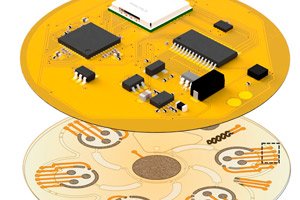
All iLive content is medically reviewed or fact checked to ensure as much factual accuracy as possible.
We have strict sourcing guidelines and only link to reputable media sites, academic research institutions and, whenever possible, medically peer reviewed studies. Note that the numbers in parentheses ([1], [2], etc.) are clickable links to these studies.
If you feel that any of our content is inaccurate, out-of-date, or otherwise questionable, please select it and press Ctrl + Enter.
Sweat test for stress: what do cortisol and adrenaline tell us?
Last reviewed: 09.08.2025

Engineers from Caltech and colleagues have demonstrated “Stressomic,” a soft, wearable laboratory patch that simultaneously monitors three key stress hormones: cortisol, adrenaline, and noradrenaline, using drops of sweat. The device itself induces sweat by local microcurrent stimulation, delivers it through microchannels to mini-reactors, takes measurements, and wirelessly sends the data to a phone. All this in continuous mode. The study was published in the journal Science Advances.
Why is this necessary?
It is convenient to assess stress by pulse or questionnaires, but these are indirect measures. Biochemistry is more accurate: cortisol reflects a longer response of the HPA axis (hypothalamus-pituitary-adrenal glands), and adrenaline/noradrenaline reflects a quick release of the sympathetic nervous system ("fight or flight"). In reality, both circuits are intertwined, so multiplex (several hormones at once) and dynamic (over time) measurement gives a much more complete picture.
How it works inside
- The patch induces local sweating using iontophoresis through hydrogels with carbachol - sweat appears without training and stress.
- Next, microfluidics with capillary burst valves delivers sweat in portions into the analysis chambers, reagents are automatically added there, and then the chamber is “refreshed” so that the sensors do not become oversaturated.
- The electrodes are made on laser-etched graphene with “golden nano-dendrites”: such a rough-porous surface provides hypersensitivity down to picomolar concentrations of adrenaline/noradrenaline.
- The measurements themselves are competitive electrochemical immunoassays with methylene blue as a redox label: the more hormone in the sample, the weaker the signal.
The entire circuit is designed for low-noise, reproducible “take-offs” with drift compensation and the influence of sweating rate.
Checking the accuracy
The authors first calibrated the sensors on solutions, then compared the readings on human sweat with ELISA (the laboratory "gold standard") - the agreement is good. In addition, they showed a reasonable connection between the levels in sweat and the levels in blood serum (correlations on dozens of samples).
What did you see on people?
The patch was tested in three scenarios:
- Physical stress (HIIT): rapid peaks of adrenaline/noradrenaline and a slower wave of cortisol.
- Emotional stress (viewing the validated IAPS image set): more pronounced contribution of "fast" catecholamines at low total sweating - exactly where pulse/GSR is not always reliable.
- Pharmacological/nutritional modulation (“supplementation” in the article): the hormone profile changes predictably, which demonstrates the suitability of the system for assessing the effects of interventions.
- The main feature is the different time “signatures” of the three hormones: by the shape of the curves, one can distinguish between an acute and a more protracted stress response and their “roll call” between the sympathetic and HPA axis.
How is this better than cortisol alone?
Cortisol alone will miss short bursts of stress; catecholamines alone won't tell you about chronic stress. A joint continuous profile covers both tasks, and also allows you to see maladaptive responses (for example, when catecholamines "fire" and the cortisol response is delayed, or vice versa).
Limitations to keep in mind
- This is an engineering study: not a medical device on the market or a diagnostic tool for anxiety disorders/burnout.
- Sweat is a complex matrix: secretion rate, skin temperature, pH, composition can affect the signal. The authors take them into account constructively, but clinical validation is still ahead.
- The relationship between sweat levels and body condition has been confirmed in limited samples; longer and more diverse studies are needed for clinical use.
Authors' comments
- J. Tu (lead author): "We have shown for the first time that multiple stress-related hormones can be read simultaneously and continuously from sweat, rather than just one marker. This brings stress monitoring closer to real human physiology."
- Wei Gao (corresponding author): “The fact that this skin device works in real time and without needles opens the way to personal monitoring of psychophysiological states - from stress management to assessing the effectiveness of therapy.”
- Electronics/Signals Engineer: We built signal processing right at the edge of the device: noise filtering, sweat flow calibration, and signal conversion into real-time biomarkers. This makes the patch independent of fixed equipment and suitable for everyday wear.
- Clinical co-author (endocrinology): The key novelty is the simultaneous reading of “fast” hormones (epinephrine/norepinephrine) and “slow” cortisol. Their combined profile better reflects stress physiology than either single marker, and this is important for interpreting data in humans.
- Microfluidics Specialist: We have achieved stable operation with low sweat volumes and user movement. The channels are self-filling, and the sensors automatically compensate for sweat rate so that the concentrations are correct and not "diluted".
- Algorithm/AI Developer: The model takes into account individual baselines and is trained to distinguish physiological stress from artifacts such as heat or exercise. This makes the signal more “behaviourally” useful.
- Project Manager: This is not a medical diagnosis out of the box, but a platform. The next steps are longer wearable studies, calibration for different user groups and, if necessary, moving towards clinical validation for specific scenarios - from sports to stress monitoring at work.
What can this give further?
Personal stress monitoring (sports, shift work, pilots/doctors), assessment of psychotherapy and training effectiveness, smarter wearables, early detection of harmful stress response patterns. And in research, a new tool to dissect stress biology on natural time scales.
